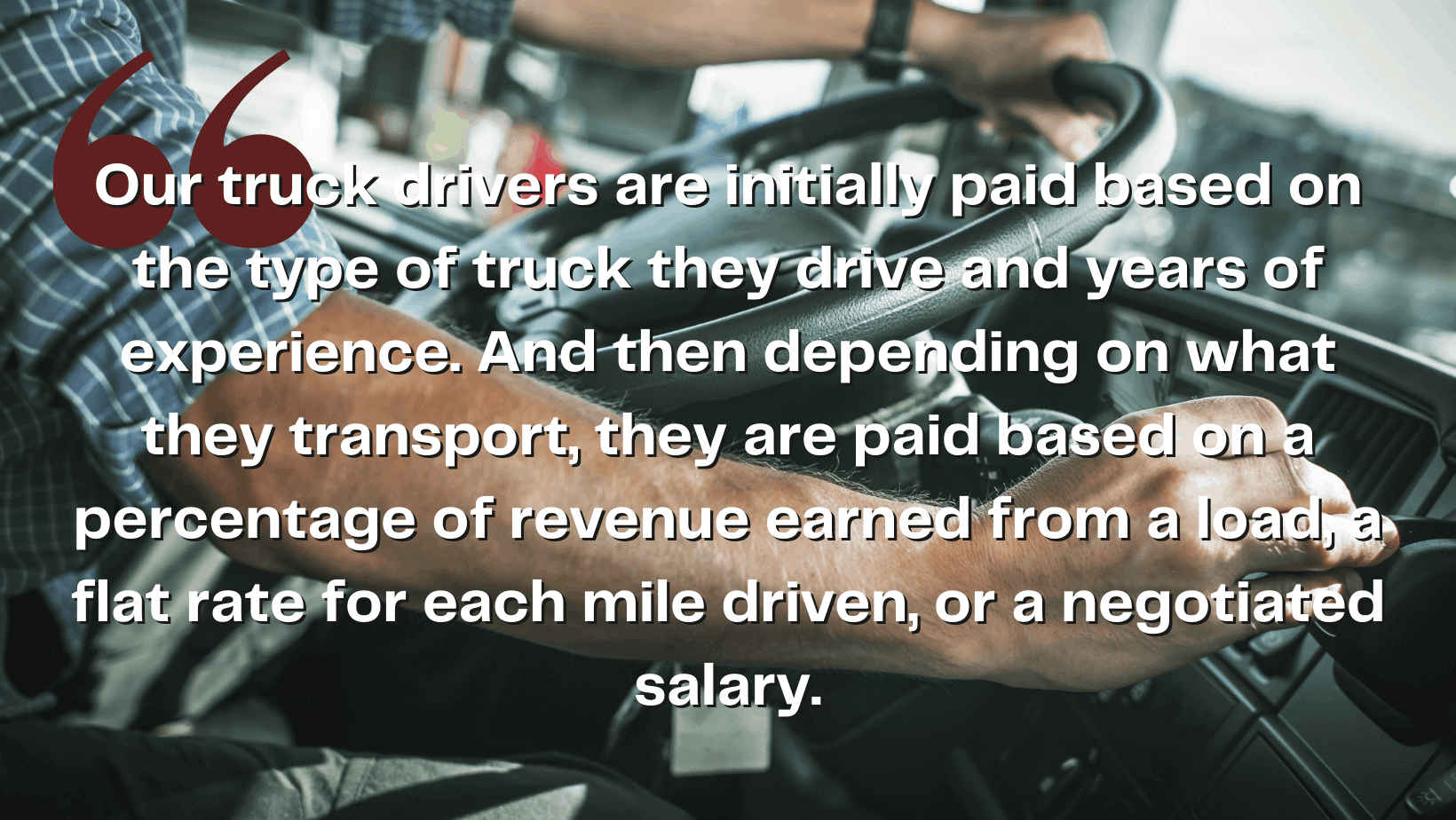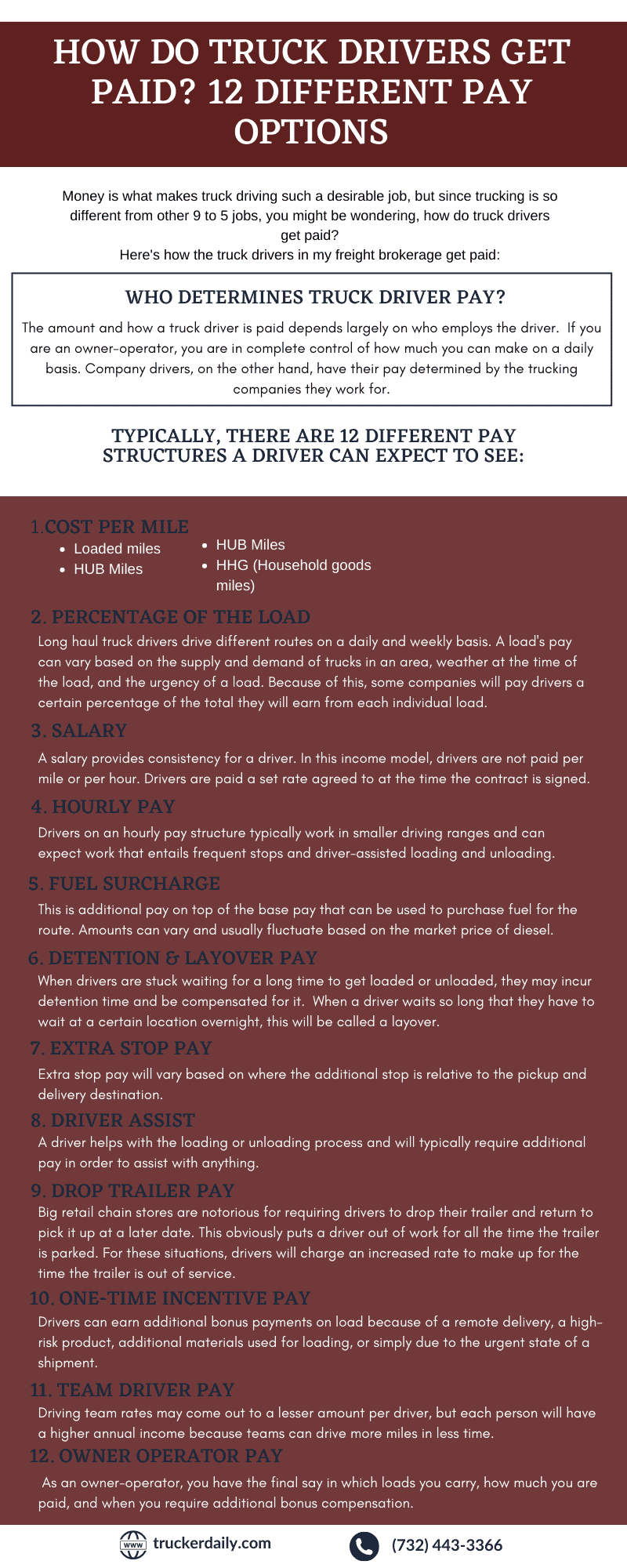Money is what makes truck driving such a desirable job, but since trucking is so different from other 9 to 5 jobs, you might be wondering, how do truck drivers get paid?
Here's how the truck drivers in my freight brokerage get paid:
Our truck drivers are initially paid based on the type of truck they drive and years of experience. And then depending on what they transport, they are paid based on a percentage of revenue earned from a load, a flat rate for each mile driven, or a negotiated salary.
I can't speak on behalf of all trucking companies, but most truck drivers also have the opportunity to earn bonuses on top of their regular pay.
Certain things happen during a driver's load that can result in earning extra pay for accessorials like waiting time, driver assists, or if they are delivering to a remote location.
Here is a very interesting overview of the costs in US $ of a truck (per mile). This kind of cost summary is also available for each of your units in MIR-RT!
Source: American transportation institute#Trucking #truckingindustry #GMAO #DataDis pic.twitter.com/6iZDfMdEXQ
— DataDis (@datadis) November 11, 2019
Who Determines Truck Driver Pay?
The amount and how a truck driver is paid depends largely on who employs the driver.
If you are an owner-operator, you are in complete control of how much you can make on a daily basis. It is up to you as the driver and sole proprietor to accept loads that pay enough to cover your overhead and leave enough left over to turn a healthy profit for your business.
As an owner-operator, you have the ability to reject low-paying loads offered by brokers and shippers. Ultimately leaving your salary in your own hands.
Company drivers, on the other hand, have their pay determined by the trucking companies they work for. As a company driver, most of the risks of operating, like liability for the loads you haul, insurance expenses, and truck repairs, are absorbed by the company you drive for.
This gives them total influence over how much you are making while you operate under their authority. Nowadays, truck drivers are in short supply, so luckily, you won't find many low paying trucking jobs out there.
Typically, there are 12 different pay structures a driver can expect to see:

1. Cost Per Mile
Cost per mile is one of the most common forms of payment in the industry because it's so easily measured. There are technology solutions that provide 100% accurate mileage measurements as well as odometers in the truck that give a driver full visibility into how much they could expect to be paid.
The only aspect of per mile pay that can vary from one trucking company to another is the type of mileage a driver is paid for. It's possible that a driver can have different pay scales for the different types of miles driven.
- Loaded miles: Also known as practical mileage, this is the number of miles based on the driving route between your shipper and receiver. Due to road weight limitations and other local laws, trucks might have to take different routes as opposed to a normal car. So just plugging addresses into your favorite directions app won't give you an accurate estimate of your actual pay.
Loaded miles are usually calculated based on readings from electronic log devices (ELD) that track driver's locations and miles during a route.
- Deadhead miles: Deadhead is a term that drivers use that refers to the miles they will drive empty in order to pick up their next load. Since every mile burns fuel and puts extra wear and tear on a truck, driving empty comes at a cost to drivers.
Sometimes a company will pay a lesser per-mile rate for empty miles driven to cover fuel costs.
- HUB Miles: Also called actual miles, is the least complex form of per mileage pay. With this CPM model, a driver will be compensated the same amount for every single mile driven. You can easily calculate how much you will be paid as a driver simply by looking at the change in your odometer.
It accounts for every mile you drive, including deadhead miles, loaded miles, out-of-route miles, and miles driven back to your company's yard.
- HHG (Household goods miles): HHG miles or zip code miles are usually seen in local trucking routes. This pay is based on the distance between post offices in both the shipper and the receiver's town or city.
If you are considering accepting a job on a CPM pay scale, the company should always include an estimate of how many miles a driver should expect per week.
Don't just jump at the first job you see based on a high CPM though. Make sure to read every word of your contract to see exactly which miles you'll be paid for based on the 4 types of CPM we discussed above.
Optimally you want to see a job with a high CPM that compensates you for the most miles you drive.
2. Percentage of the Load
Long haul truck drivers drive different routes on a daily and weekly basis. A load's pay can vary based on the supply and demand of trucks in an area, weather at the time of the load, and the urgency of a load. Because of this, some companies will pay drivers a certain percentage of the total they will earn from each individual load.
Say, for example, a load from NJ to California is paying $6000. Your driver agreement guarantees you 85% of each load you drive. Your pay for that load would come out to $5100. Not bad for a few days of work!
This structure has more upside potential for a truck driver but also more risk because your ability to work depends on the loads available at any given time.
3. Salary
A salary provides consistency for a driver. In this income model, drivers are not paid per mile or per hour. Drivers are paid a set rate agreed to at the time the contract is signed. This might be the most consistent pay model, but the upside potential is limited.
4. Hourly Pay
Some drivers are still paid on an hourly basis. Drivers on an hourly pay structure typically work in smaller driving ranges and can expect work that entails frequent stops and driver-assisted loading and unloading.
As a trucker, I’ll give you some insight on the shipping costs. Whenever fuel prices go up shipping prices are in parallel! Look at the fuel prices before the election. That tells you everything. Fuel surcharge gets charged back to the customer when fuel goes up above $1.25/g pic.twitter.com/yJvtojarG3
— FUNkyMONkEY (@ChuckMetzer) June 29, 2021
How Can I Make More Money as a Truck Driver?
Driving can be unpredictable. Drivers have the opportunity to earn extra compensation through a number of different scenarios that can occur through the course of a load.These are often called "accessorial charges" and can include any of the following:
5. Fuel Surcharge
Most owner-operators and some companies offer drivers a fuel surcharge. This is additional pay on top of the base pay that can be used to purchase fuel for the route. Amounts can vary and usually fluctuate based on the market price of diesel.
6. Detention & Layover Pay
Sometimes shippers and receivers make drivers sit for long periods. This can happen due to a high volume of shipments on a given day or poor organization. When drivers are stuck waiting for a long time to get loaded or unloaded, they may incur detention time and be compensated for it. Typically drivers allow 2 hours for free at the shipper and receiver before charges start to collect.
When a driver waits so long that they have to wait at a certain location overnight, this will be called a layover. Since a driver will miss out on compensation for hauling a load, layover pay will make up for their lost earnings.
7. Extra Stop Pay
When drivers have to make multiple stops on a single load, an extra stop payment is required. Extra stop pay will vary based on where the additional stop is relative to the pickup and delivery destination. Just like detention pay, stop pay compensates a driver for lost earning potential. Since an extra stop means less time on the road, payment for that time will make up the difference.

8. Driver Assist
Loading is usually the responsibility of the shipper and receiver, but sometimes a driver will need to assist. It's mostly due to inexperienced loaders or a requirement of the location. A driver helps with the loading or unloading process and will typically require additional pay in order to assist with anything.
9. Drop Trailer Pay
Big retail chain stores are notorious for requiring drivers to drop their trailer and return to pick it up at a later date. This obviously puts a driver out of work for all the time the trailer is parked. For these situations, drivers will charge an increased rate to make up for the time the trailer is out of service.
10. One-time Incentive Pay
Drivers can earn additional bonus payments on load because of a remote delivery, a high-risk product, additional materials used for loading, or simply due to the urgent state of a shipment. Specialized trailers like flatbeds and reefer units are known to carry premiums just due to the scarcity of equipment and extra skill required to operate them safely.
11. Team Driver Pay
To maximize the mileage a truck can drive, some drivers team up with one or more drivers to cover more ground legally. Team driver pay can vary based on any of the models we mentioned already, but in the case of a team, the drivers will share the rate.
Driving team rates may come out to a lesser amount per driver, but each person will have a higher annual income because teams can drive more miles in less time.
Teams of drivers with varying experience may have a different rate per driver.
12. Owner Operator Pay
Independent owner-operators have the most control over their pay. As an owner-operator, you have the final say in which loads you carry, how much you are paid, and when you require additional bonus compensation.
Owner-operators usually get their loads directly from shippers or with the help of a freight broker. They will negotiate for each load independently based on a linehaul rate and fuel surcharge.
Independent owner-operators will take home the full revenue from a shipment. On the contrary, owner-operators leased to another authority might have to give up a small percentage of the linehaul (gross revenue of the load minus the fuel surcharge).
Conclusion
Just like the trucking industry is diverse, so are the different ways a truck driver can be paid.
Knowing all of these payment structures and additional pay opportunities can go a long way in helping you negotiate more money as a driver and maximize your earnings.
